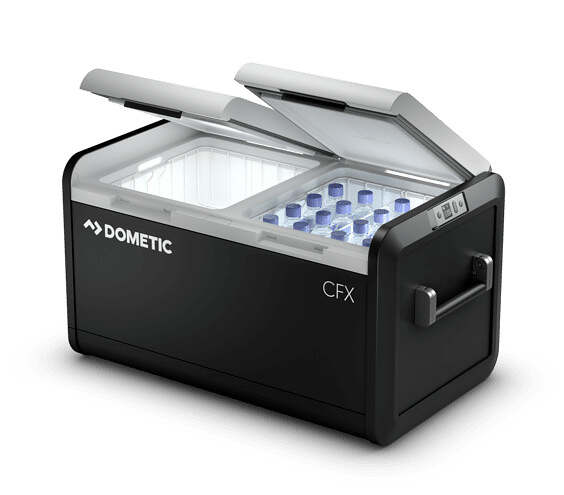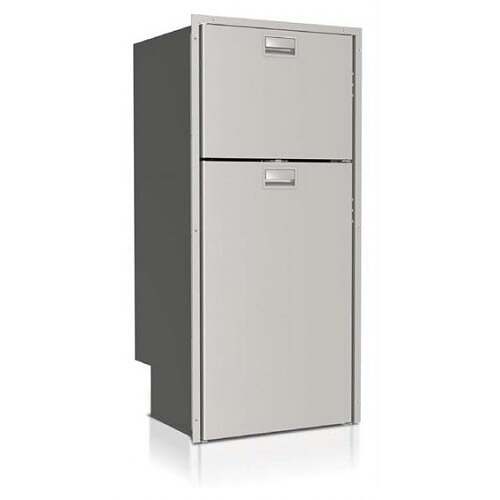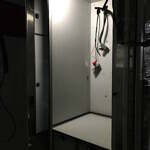Selecting a refrigerator, or some means to preserve food in a mobile application, involves a lot of considerations. Options include everything from a simple cooler full of ice to 12V coolers, to upright units with combined or separate fridge and freezer sections that can run off DC or AC power. You have to consider how much food you have to store and for how long as well as the available power supply. A family of four staying in a campground for a long weekend will have very different requirements than a single person living full time in their vehicle. It’s also important to consider the available space. Does it need to fit under a counter? How often will you access it? Which way will the door open? Some can even double as pull-out seating.
The basic power options are of course, AC or DC and which you choose has a significant impact on the price. AC fridges are far cheaper, but powering them in a vehicle requires an inverter, which has it’s own power usage on top of the fridge.
DC refrigerators are generally designed specifically for the marine/RV/truck market and besides focusing on efficiency, both through how they are powered as well as insulated, also include features such as doors that latch or even options for doors or drawers for the refrigerator and freezer sections or even separate units for both. Some manufactures even sell separate cooling units, so you can fabricate your own space to cool/freeze. However, be prepared for a bit of sticker shock, as DC fridges are significantly more expensive than their AC counterparts. It’s important to remember you are buying efficiency not volume.

As my overall plan was delayed and the timeline shortened, I had figured that I would just go with a 12V, top-loading plastic cooler-style unit and hold off on considering a built-in until I did a full interior renovation. These top-loaders basically look like oversized coolers, but are typically divided into two sections, either of which can be a refrigerator or freezer. However, the more I looked at these the less I liked them. They aren’t all that inexpensive and in fact, given their comparatively small volume compared to a “real” fridge, seem fairly expensive to me. The top-loading also seems like a nuisance for full-time living as even if it’s tucked away on drawer slides, using it means taking up valuable horizontal space.
Once I started measuring and figuring out how my truck was put together I realized I had two options for an upright refrigerator unit. The first is the cabinet to the right of the side entry. Even though it has upper and lower doors and set a drawers, this is actually one tall cabinet with only a small 18″ cabinet below floor level. The shelves and drawers are mounted in C-channel and can be adjusted to any height and the exterior doors completely removed. The very bottom of the cabinet can be accessed from the outside locker door and with some minor modifications I can also make use of the built-in vents in the bottom cabinet to provide a heat exhaust for the refrigeration compressor. The other option was where the CPR seat was located. However, while this would fit a decent sized fridge as far as height and width, it is rather shallow and the fridge would stick out 6-8″ from the rest of the cabinets.
The above gallery shows before and after pics of the cabinet I modified for the fridge. The after was taken with the garage lights off so you can’t really see the whole cabinet. I’ll do a more detailed post on how I modified the cabinet at some point.
I had originally budgeted for a stainless steel, DC, side-by-size made by IsoTherm. Once I considered how I currently used my fridge, I decided this was much bigger than I likely needed besides being to big to fit into the existing cabinet. After a fair amount of research I settled on a Vitrifrigo 8.1 cubic foot fridge/freezer. I’d never heard of them, but they are a well known brand in the marine and RV industry. I did decide to splurge a bit and go with stainless steel over a painted finish, though I still came in well under my original budget.

I’ve been asked why the focus on DC power and why pay so much more for a DC powered refrigerator when small AC fridges can be had for a couple hundred dollars? There are two reasons: First 12 or 24 volts is much safer than 110V AC. You might feel a little tingle with 24V, but anything below 30V is considered safe. 110V AC is going to hurt, and while it may not kill you, it’s no picnic as those of you who have been zapped by an outlet know. Second, battery banks are DC, so to make AC power it has to go through an inverter, which has it’s own parasitic loss associated with inverting DC to AC. My battery system will be 24V and the biggest single use of that power will be the refrigerator. The fridge I selected can run off 12V/24V DC or 110V/220V AC (this is rather convenient as I’ve had it plugged in at the garage to keep my beer cold.) I plan to run it at 24V directly from the batteries for optimum efficiency. Running 24V rather than 12V means moving half the amps, which means I can use use thinner and therefore less expensive wire.
If this was going to be a weekend camper or only used a few times a year, I could get away with a regular AC fridge. Since my plan is to be living in the truck full time and be self-sufficient for 30 days, it’s worth it to me to make everything as efficient as possible. Not only are DC fridges more efficient power-wise, they are also more compact, which was important to fit in the space I had available. DC fridges designed for boats and RVs are also typically better insulated than your household type units for a given size and I wanted the doors to have latches so they wouldn’t be popping open while driving.
Fridges and freezers are also more efficient when filled to near capacity as opposed to being mostly empty space as it makes for more cold mass when the door is opened. Looking at how I use my current fridge, I’d estimate it’s maybe 25% full at any given time so there is lots of wasted space. I sized my new fridge to be 80% full with the goal of also storing more fresh fruits and vegetables than I do at present…or more likely, just more All Day IPA.

